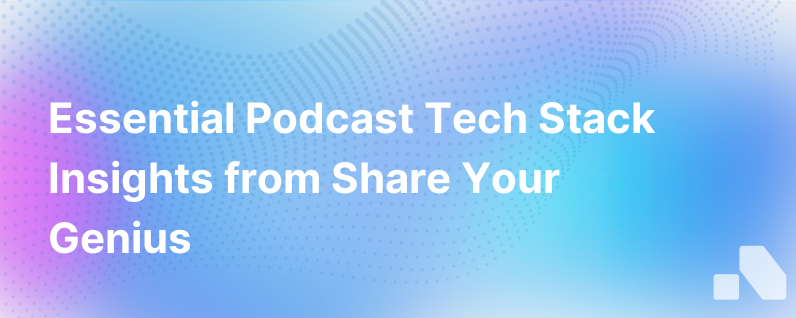
In today's digital world, where content is king, podcasts have risen as a dynamic medium for storytelling, brand-building, and thought leadership. The auditory experience of a podcast offers a unique intimacy that can forge a special connection with your audience. But with countless podcasts vying for listeners' attention, creating a high-quality show requires more than just great content—it demands a robust tech stack.
At Share Your Genius, we’ve been paving the way in podcast production, understanding the intricate nuances of crafting a compelling audio experience for various audiences. In this article, we delve into a comprehensive guide on structuring your podcast tech stack, ensuring you're equipped with the necessary tools to not only start a podcast but excel in producing one that stands out.
Building Your Podcast Tech Stack
The podcast tech stack refers to the collection of hardware and software tools that you employ throughout the podcasting process—from ideation to recording, editing, publishing, and analysis. Let’s break down the key components you need.
1. Ideation and Scripting
Before you hit record, your podcast needs shape and direction. Tools like Google Docs for writing scripts and Trello for organizing episode flows can be essential. Collaborative platforms like Airtable or Notion can also help organize your thoughts and structure your content efficiently.
2. Recording Equipment
High-quality audio is non-negotiable. Here's what you need:
- Microphones: Invest in professional-grade microphones. Options like the Shure SM7B or the Rode PodMic can offer excellent sound quality.
- Headphones: Closed-back headphones like the Audio-Technica ATH-M50x prevent audio leaks and allow for precision monitoring.
- Audio Interface: A reliable interface like the Focusrite Scarlett 2i2 converts the microphone signals into a digital format your computer can use.
3. Recording Software
Whether you’re in a studio or recording remotely, robust software is key:
- Local Recording: Tools like Adobe Audition or Logic Pro X offer advanced recording and editing features for studio-quality podcasts.
- Remote Recording: Zencastr or SquadCast can simultaneously record local audio for every guest/participant, minimize latency, and ensure higher audio quality.
4. Audio Editing Tools
Editing is where the magic happens. Here’s what to consider:
- Advanced Software: Adobe Audition, Pro Tools, and Logic Pro X grant you deep control over the final product.
- Simpler Software: For quick edits without a steep learning curve, tools like Audacity or GarageBand could suffice.
5. Hosting Services
A hosting platform stores and distributes your podcast. There are myriad options, each with its own advantages:
- Libsyn: One of the oldest players in the game, Libsyn offers podcast hosting with a flat fee, ample storage, and support for monetization.
- Podbean: With an easy-to-use interface, unlimited hosting plans, and promotional tools, Podbean is a favorite among podcasters.
- Anchor: A Spotify-owned platform that offers free hosting and direct integration with Spotify, making distribution seamless.
6. Syndication
Getting your podcast on as many platforms as possible is essential for maximum reach:
- RSS Feed: Your hosting service will supply an RSS feed which you can submit to directories like Apple Podcasts, Google Podcasts, Stitcher, and Spotify to ensure your podcast is widely available.
- Podcast Directories: Submit your podcast to as many reputable directories as possible for further reach.
7. Sound Effects and Music Libraries
The right music and sound effects can elevate your podcast:
- Royalty-Free Music: Services like Epidemic Sound or AudioJungle provide high-quality royalty-free tracks that add mood and professionalism to your audio.
- Sound Effects Libraries: BBC Sound Effects or Soundsnap offer expansive libraries to enhance storytelling.
8. Website and Marketing Tools
Having a dedicated webpage and social presence for your podcast is important for discovery and engagement:
- Website Platforms: WordPress or Squarespace for creating a podcast website with integrated players.
- Email Marketing: Mailchimp or ConvertKit to keep your subscribers updated and nurture your community.
- Social Media Management: Buffer or Hootsuite to schedule and manage posts across various platforms.
9. Analytics Tools
Understanding your audience and their preferences help in fine-tuning your content:
- Internal Analytics: Platforms like Podtrac or your hosting provider often have analytics capabilities.
- Website Analytics: If you have a website, Google Analytics tracks listenership and engagement on your site.
10. Backup Solutions
Never underestimate the need for backups:
- Cloud Storage: Google Drive or Dropbox to store recordings safely in the cloud.
- Physical Storage: External hard disks or NAS systems as local backups.
Conclusion
As you assemble your podcast tech stack, it’s important to evaluate each component not just individually but how it fits within your overall production process. The right tech stack should empower you to produce high-quality content efficiently, distribute it effectively, engage your audience meaningfully, and scale your podcast over time.
Every podcast has its unique flavor and requirements, and your tech stack should be dynamic enough to accommodate those needs. Whether you’re a podcasting novice or an audio aficionado, investing in a well-considered tech stack can be the difference between being just another show among thousands and becoming the next audio sensation. At Share Your Genius, we believe in the power of great storytelling and the right technology to share it—with clarity, depth, and impact.